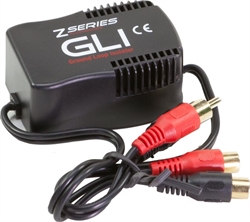
The plug the ground are making intermittent or lightĬontact with the tang on the inside of the outlet, it can cause a hum Hum can enter into your home theater setup.Ĭheck to see if you have a heavy power cord or an outlet in the wall Problem, realize that there are plenty of ways in which system buzz and

While this article addresses a very common ground loop
#AUDIO GROUND LOOP ISOLATOR TV#
Eureka ! There must be a ground loop in the system involving the Cable TV line. Does the hum go away? It did in the case of Reference System 3. The final test is to unplug your Cable TV cable from the wall. One other test to eliminate your receiver or processor is to see if the hum changes based on what input you have selected (DVD player, Cable TV, etc.) Does the hum change or go away when selecting a different input? No? Then your problem is occurring at a later stage in the system (most likely a ground loop caused by the addition of an amplifier or powered subwoofer with a 3-prong power cable.) unplugging the cable from the wall to see if the Cable TV is the source of a ground loop.)

Chances are, you can more easily isolate a problem if it just starting with the addition of a new piece of equipment. Note any recent changes to the system that brought on this problem.Start with the processor receiver to determine if the hum/buzz is source-related or due to a ground loop occurring after the amplification stage.It if occurred prior, then the receiver/processor would typically raise the overall level of noise. For example, if adjusting the volume on your processor/receiver does not alter the hum level, then the problem must be occurring after that point. Troubleshooting ground loops involves taking things in order and checking a few basic, common elements to see if the problem is simple, or complex. In addition, you may end up making more and more work since you are expending energy in areas that don't have any effect on the problem at hand. For example, if you simply start flailing away, swapping gear and cables and everything all at once, you may never know what actually caused (or fixed) the problem. To accurately determine the correct solution to a problem you first have to find and isolate it. Diagnosing and Troubleshooting the Problem Implement assuming the transformer has sufficient bandwidth, isn't tooĬostly or bulky, and a direct DC signal path is not required for theĪpplication. The noise coupling is primarily a function of parasitic capacitanceīetween the transformer windings and can be reduced by placing a shieldīetween the windings. Interrupting ground continuity, hence breaking ground loops.īy using an isolation transformer, the ground noise voltage will nowĪppear between the transformer windings and not circuit input. Signals, allows all the desired signals to pass freely, while The most practical and usually most cost effective method for consumer audio applications is to use an isolation transformer.Īn isolation transformer is a device which, in the case of cable Mode choke, optical coupler, balanced circuitry, or frequency selective Isolate one of the ground paths with an isolation transformer, common.Remove one of the ground paths, thus converting the system to a single point ground.Or 50Hz/60Hz hum in audio or video equipment. These multiple paths and develop voltages which can cause damage, noise Potential difference between the two grounds can cause unwanted noise Thus, a system grounded at two different points, with a Through different paths, ground path noise, or a ground loop can occur. When two or more devices are connected to a common ground

Now, how do you solve it? First it helps to define exactly what a ground loop is and how it may affect our home theater system. If this has happened to you the chances are it's a ground loop between your Cable TV and another component in your system (like an amplifier or powered subwoofer).

Immediately after placing the amp in my system a very noticeable 60Hz hum starting pouring from my speakers. It was an amplifier that came with a three-prong power cable. Several weeks ago I was pulling my hair out after I installed a new component into Reference System 3 for review. Congratulations - you've just entered The Ground Loop Zone. You're running your gear through power conditioners and you're beating your head against the wall trying to figure out what's up. You've just connected your system and there's a buzz or hum that won't go away.


 0 kommentar(er)
0 kommentar(er)
